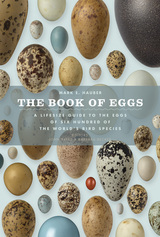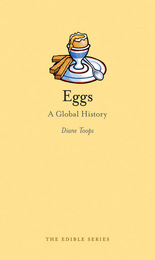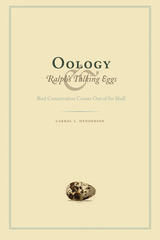
The Book of Eggs introduces readers to eggs from six hundred species—some endangered or extinct—from around the world and housed mostly at Chicago’s Field Museum of Natural History. Organized by habitat and taxonomy, the entries include newly commissioned photographs that reproduce each egg in full color and at actual size, as well as distribution maps and drawings and descriptions of the birds and their nests where the eggs are kept warm. Birds’ eggs are some of the most colorful and variable natural products in the wild, and each entry is also accompanied by a brief description that includes evolutionary explanations for the wide variety of colors and patterns, from camouflage designed to protect against predation, to thermoregulatory adaptations, to adjustments for the circumstances of a particular habitat or season. Throughout the book are fascinating facts to pique the curiosity of binocular-toting birdwatchers and budding amateurs alike. Female mallards, for instance, invest more energy to produce larger eggs when faced with the genetic windfall of an attractive mate. Some seabirds, like the cliff-dwelling guillemot, have adapted to produce long, pointed eggs, whose uneven weight distribution prevents them from rolling off rocky ledges into the sea.
A visually stunning and scientifically engaging guide to six hundred of the most intriguing eggs, from the pea-sized progeny of the smallest of hummingbirds to the eggs of the largest living bird, the ostrich, which can weigh up to five pounds, The Book of Eggs offers readers a rare, up-close look at these remarkable forms of animal life.

The beauty of the robin’s egg is not lost on the child who discovers the nest, nor on the collector of nature’s marvels. Such instances of wonder find fitting expression in the photographs of Rosamond Purcell, whose work captures the intricacy of nests and the aesthetic perfection of bird eggs. Mining the ornithological treasures of the Western Foundation of Vertebrate Zoology, Purcell produces pictures as lovely and various as the artifacts she photographs. The dusky blue egg of an emu becomes a planet. A woodpecker’s nest bears an uncanny resemblance to a wooden shoe. A resourceful rock dove weaves together scrap metal and spent fireworks. A dreamscape of dancing monkeys emerges from the calligraphic markings of a murre egg.
Alongside Purcell’s photographs, Linnea Hall and René Corado offer an engaging history of egg collecting, the provenance of the specimens in the photographs, and the biology, conservation, and ecology of the birds that produced them. They highlight the scientific value that eggs and nest hold for understanding and conserving birds in the wild, as well as the aesthetic charge they carry for us.
How has evolution shaped the egg or directed the design of the nest? How do the photographs convey such infinitesimal and yet momentous happenstance? The objects in Egg & Nest are specimens of natural history, and in Purcell’s renderings, they are also the most natural art.

After explaining the many varieties of eggs and the places that favor them, Toops sketches a history of its uses from its origins until the present day, when it has become an integral part of modern cuisine. She explores how eggs are today marketed as a health food and discusses the debates over their nutritional status. Filled with appetizing recipes and beguiling images, this protein-packed book will enthrall anyone with an interest in cuisine or cultural history.

Before modern binoculars and cameras made it possible to observe birds closely in the wild, many people collected eggs as a way of learning about birds. Serious collectors called their avocation "oology" and kept meticulous records for each set of eggs: the bird's name, the species reference number, the quantity of eggs in the clutch, the date and location where the eggs were collected, and the collector's name. These documented egg collections, which typically date from the nineteenth and early twentieth centuries, now provide an important baseline from which to measure changes in the numbers, distribution, and nesting patterns of many species of birds.
In Oology and Ralph's Talking Eggs, Carrol L. Henderson uses the vast egg collection of Ralph Handsaker, an Iowa farmer, as the starting point for a fascinating account of oology and its role in the origins of modern birdwatching, scientific ornithology, and bird conservation in North America. Henderson describes Handsaker's and other oologists' collecting activities, which included not only gathering bird eggs in the wild but also trading and purchasing eggs from collectors around the world. Henderson then spotlights sixty of the nearly five hundred bird species represented in the Handsaker collection, using them to tell the story of how birds such as the Snowy Egret, Greater Prairie Chicken, Atlantic Puffin, and Wood Duck have fared over the past hundred years or so since their eggs were gathered. Photos of the eggs and historical drawings and photos of the birds illustrate each species account. Henderson also links these bird histories to major milestones in bird conservation and bird protection laws in North America from 1875 to the present.
READERS
Browse our collection.
PUBLISHERS
See BiblioVault's publisher services.
STUDENT SERVICES
Files for college accessibility offices.
UChicago Accessibility Resources
home | accessibility | search | about | contact us
BiblioVault ® 2001 - 2024
The University of Chicago Press









